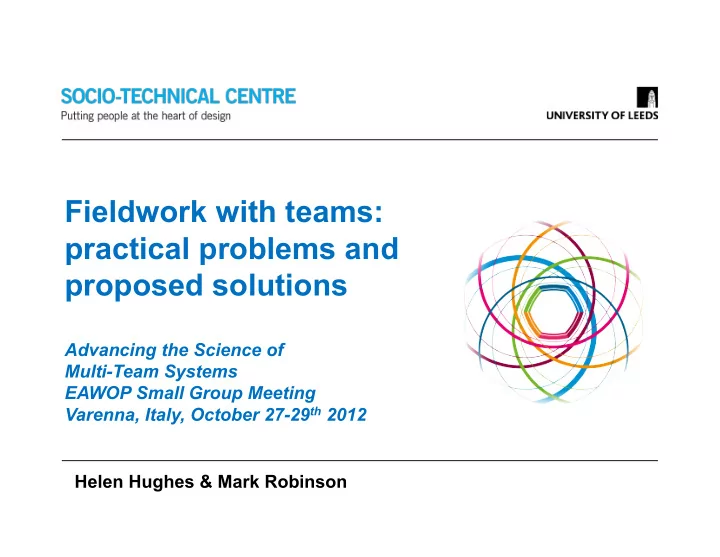

Fieldwork with teams: practical problems and proposed solutions Advancing the Science of Multi-Team Systems EAWOP Small Group Meeting Varenna, Italy, October 27-29 th 2012 Helen Hughes & Mark Robinson
Objectives − To identify some potential problems encountered when undertaking applied MTS research − To propose some potential solutions and future directions for MTS research − To encourage debate on these issues
Problem 1: Multi-team membership • Matrix organizational structures are increasingly common • Results in a multi-team system (MTS) with multi-team memberships • Conflicting demands and competing goals at inter- and intra-team levels • Optimal MTS performance requires trade-offs in team performance Matrix ¡structure ¡ Vehicle ¡model ¡A ¡ Vehicle ¡model ¡B ¡ Vehicle ¡model ¡C ¡ Vehicle ¡model ¡D ¡ Vehicle ¡model ¡E ¡ Component ¡1 ¡ ¡ ¡ ¡ ¡ ¡ Component ¡2 ¡ ¡ ¡ ¡ ¡ ¡ Component ¡3 ¡ ¡ ¡ ¡ ¡ ¡ Component ¡4 ¡ ¡ ¡ ¡ ¡ ¡ Component ¡5 ¡ ¡ ¡ ¡ ¡ ¡
Problem 1: Multi-team membership (continued...) Goals: People: Shared Conflicting time cognition demands Processes/ procedures: Culture: Concurrent Multiple social engineering identities Technology: Buildings/ Software infrastructure: integration Co-location
Problem 2: Non-aligned team definitions (continued...) Academic definitions (e.g., Hackman, 2002; Salas et al., 2004) • 2-8 people • Integrated working • Social interaction • Shared identity • Shared objectives • Shared cognition • Shared accountability • Laboratory experiments • Emergency services, military
Problem 2: Non-aligned team definitions (continued...) Organizations’ own definitions • 2-50 people • Isolated working + meetings • Time allocation (Robinson, 2012): • 60% solo work • 40% social work (27% unplanned + 13% planned) • Extra-team working • Some competing goals • Membership ambiguity • Real teams do exist, but may not be labelled as such
Problem 3: Transitory teams and membership
Solution 1: Develop and modify variables • For team performance, distinguish between completion time and working time, by incorporating the variable availability (Crowder et al., 2012) • Increased focus on work tasks and structures and implications for MTS Member 1 Member 1 Member 2 Member 2 Member 3 Member 3 Member 4 Member 4 Member 5 Member 5
Solution 2: More sensitive methodologies − Social network analysis − Agent based modelling and simulation
Social network analysis Knowledge sharing within and between different supply chain units Shepherd (2008)
SNA as a tool for researching teams − Highly sensitive methodology (Murase et al, 2012) − Multi-level information − Dyadic characteristics − Team emergence and evolution − How is work actually being done? (e.g., Cross & Parker, 2004) − Might help researchers to better understand: − E.g. Leadership, cohesion – what does an ‘effective’ MTS look like? − Team fit within the wider MTS system.
SNA as a tool for organizations : − To capture the ‘as is’; − Design better interventions; − Design more effective organizational structures; − As a diagnostic tool; − Can/should networks be managed?
Agent based modelling and simulation (ABMS) − M icro -level decisions - macro -level outcomes − Developed from the ‘bottom up’ − Run over ‘time’ − Simple rules → complex behaviour − Can later increase complexity of rules and behaviours (e.g., see Gilbert & Troitzsch, 2005) Source: SeSAm 2.0 Multi-agent simulation Reynolds (1987)
• The nature and structure of work tasks are key within ABMS Crowder et al. (2012, p. 1433)
The benefits of ABMS for teams – see Hughes et al, 2012 1. Forces researchers to make assumptions explicit 2. Bring together knowledge and data from different sources 3. Helps researchers understand dynamic, real-world processes and outputs 7. Operate in an artificial environment
Conclusions? − Applied research fundamental to theoretical advancements − ABMS and SNA ideally placed to study MTS complexity − Complementary, not competitive approaches − Need to consider MTSs within a socio-technical framework
Thank you for listening Questions and comments? Contact details: h.hughes@leeds.ac.uk m.robinson@lubs.leeds.ac.uk
References − Cross, R., & Parker, A. (2004). The hidden power of social networks. Understanding how work really gets done in organizations. Boston, USA :Harvard Business School Press. − Crowder, R. M., Robinson, M. A., Hughes, H. P. N., & Sim, Y. W. (2012). The development of an agent-based modeling framework for simulating engineering team work. IEEE Transactions on Systems, Man, and Cybernetics – Part A: Systems and Humans, 42 (6), 1425–1439. − Gilbert, N., & Troitzsch, K.G. (2005). Simulation for the social scientist. Milton Keynes: Open University Press. − Hughes, H. P. N., Clegg, C. W., Robinson, M. A., & Crowder, R. M. (2012). Agent- based modelling and simulation: The potential contribution to organizational psychology. Journal of Occupational and Organizational Psychology, 85 (3), 487– 502.
− Murase, T., Doty, D., Wax, A., DeChurch, L.A. & Contractor, N.S. (2012). Teams are changing: Time to ‘think networks’. Industrial and Organizational Psychology, 5 (1), 41-44. − Reynolds, C. W. (1987). Flocks, herds and schools: a distributed behavioral model. Computer Graphics, 21 , 25–34. − Robinson, M. A. (2012). How design engineers spend their time: Job content and task satisfaction. Design Studies, 33 (4), 391–425. − Salas, E., Stagl, K.C., & Burke, S. (2004). 25 years of team effectiveness in organisations: Research themes and emerging needs. In Cooper, CL. and Robertson I.T. (eds.) International Review of Industrial and Organisational Psychology Volume 19 (pp. 47 – 91). John Wiley & Sons Ltd, London Author details 19
Recommend
More recommend